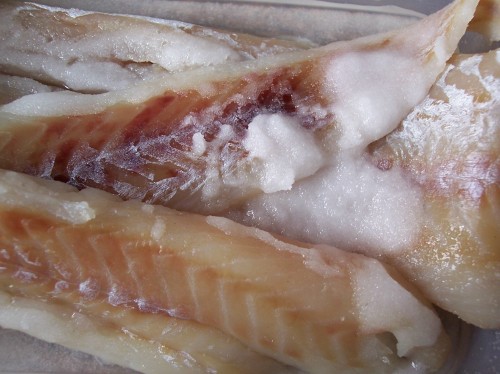The Basque Country in the western Pyrenees spans the border taking in part of South-west France and Northern Spain. The coastal part of the region, on both sides of the border, is well known for its fish. Bacalao, or Salt Cod, is a widely used ingredient in both Basque and Spanish cookery. Salted fish is often associated with Lent, the six and a bit weeks from Ash Wednesday to Easter when, at the end of a long winter, fresh produce was at a premium. I have recently added a post about how to salt fish at home, which is not a difficult process, however packs of ready salted fish is becoming more widely available in the UK. I am fortunate to live in an ethnically diverse part of North-east London so usually shop for Salt fish in a local ethnic shop with mostly Caribbean produce, but the major supermarket chains are now starting to stock it too. I usually buy salted skinless pollack, as it is a sustainable species – I am trying not to buy cod – and quite honestly I can barely tell the difference, especially when it is cooked into a stew. This recipe, therefore, has been converted for pollack, but if you must then substitute cod – or another white round fish of your choice.
The recipe comes from a library book, The Spanish Kitchen by Pepita Aris. As I have said previously I substituted ready Salted Pollack, soaked for twenty-four hours before use. I am yet to try this recipe with home salted fish. I was also a little unsure about adding the honey specified in the recipe. Honey with fish? It seemed a bit strange! However as I often add a little sugar to tomato based dishes as it cuts through the acidity I risked the honey and the flavour was not obvious. The dish was certainly enjoyable. I notice that there is a similar recipe from Central Spain in Keith Floyd’s book, Floyd on Spain, which includes chick peas. I’ll have to give that a go sometime as well, perhaps using home salted fish.

'Meanderings through my Cookbook' http://www.hopeeternalcookbook.wordpress.com
Basque Style Salt Cod (Bacalao) in Spicy Tomato Sauce
Bacalao con Salsa de Tomate Picante
(Serves 4)
400g/15oz salt cod/salt fish, soaked in cold water for 24hours
(I used a 300g pack which was adequate with extra pepper)
30ml/2tbsp olive oil
1 large onion
2 cloves garlic
2 green peppers (or one each red or orange and green)
500g/1¼ lb peeled & chopped ripe tomatoes
or
400g/14oz tin tomatoes
15ml/1tbsp tomato purée
15ml/1tbsp clear honey
¼tsp dried thyme
½tsp cayenne pepper
or
½tsp Piment d’Espelette (coarse ground dried Basque pepper)
Juice of ½ lemon
2 potatoes (medium sized)
45ml/3tbsp stale breadcrumbs (be generous – I’m sure I doubled this amount)
30ml/2tbsp finely chopped fresh parsley
Salt & ground black pepper
1. If using shop bought salt fish it should be soaked in cold water for 24 hours, drained and rinsed before use. If home made lightly salted fish is used then an overnight soak followed by a rinse should be adequate.
2. Drain the salted fish, place in a pan, generously cover with water and bring to the boil. As soon as it boils remove the pan from the heat and set aside until cold.
3. Heat the oil in a medium sized pan. Gently fry the onion for 5 minutes and then add the garlic. Add the chopped peppers and tomatoes and cook over a gentle heat to make a sauce. Stir in the tomato purée, honey, dried thyme, espelette or cayenne pepper, black pepper and a little salt. Taste and sea son as required. Add alittle lemon juice to make it ‘tangier’.
4. Peel and halve the potatoes lengthways and cut them into slices about the thickness of a coin.
5. Drain the fish and reserve the cooking water.
6. Turn on the grill to heat up. Cook the potato slices for about 8 minutes, with no added salt, in the reserved water.
7. Flake the fish and remove any skin and bones.
8. Make up the dish in layers. First put in a third of the sauce, cover with potato slices, followed by a layer of flaked fish and the finally the remainder of the sauce.
9. Combine the breadcrumbs and parsley together and sprinkle over the dish.
10. Place under the grill for 10 minutes until golden brown.
11. This is a meal in itself but if you wish it could be served with a side salad.















 Search Food Blogs
Search Food Blogs 

